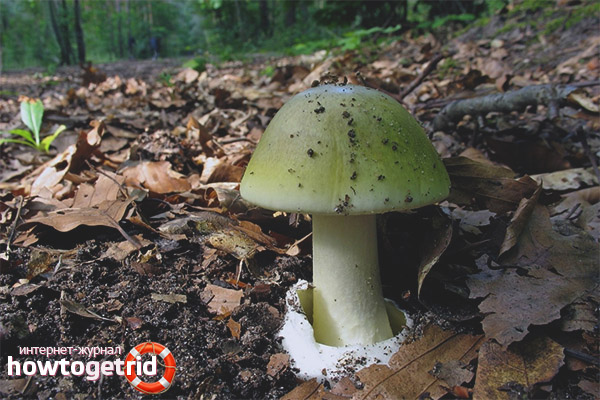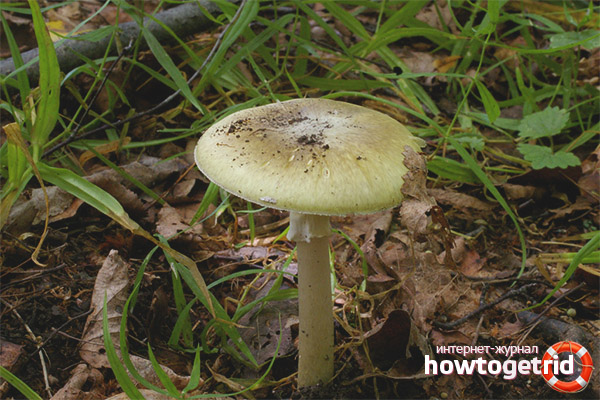The content of the article
To date, pale toadstools are considered the most dangerous poisonous mushroom, since most food poisoning occurs precisely due to the use of this mushroom in food. Experts note that in a pale toadstool the highest concentration of toxic substances from all the fungi that can be found in domestic open spaces. Every year, thousands of inexperienced mushroom pickers make a fatal mistake and harvest this dangerous kind of mushroom as a crop. This is justified by the fact that the pale toadstool has an absolutely unremarkable appearance, unlike other poisonous counterparts, and therefore visually it does not cause any apprehension or suspicion in the beginning mushroom picker. It is easy to confuse it with such famous and popular species as forest mushroom or russula. Among people, pale grebe is better known as green or white fly agaric.
What does a pale toadstool look like and what is it?
This insidious mushroom and its dangerous properties have been known to people for a very long time. A few millennia ago, during the time of Ancient Rome, many people knew what this mushroom was, and how it could be dangerous. This is justified by the fact that the ancient Romans were very fond of eating mushroom dishes, and therefore very well versed in their varieties and were first-class mushroom pickers. Most of them in appearance could accurately determine the edible mushroom in front of them or poisonous. But, despite such knowledge, royal tasters still had special tasters who tried mushroom dishes for the presence of poisoned ones. In the modern world, such tasters have long ceased to exist, since it is inhumane and illegal, and therefore all mushroom pickers, both experienced and beginners, simply must know exactly what this ill-fated mushroom looks like in order to protect itself and its loved ones from getting a pale grebe in food.
Pale grebe, or as it is scientifically called - Amanita phalloides is incredibly toxic and is one of the ten most dangerous and poisonous mushrooms in the world. It contains a large concentration of such strong toxic substances as amanitine, phalloidin and phallian.
In appearance, the pale toadstool is almost identical to forest mushroom and a greenish russula, it is with these two mushrooms that many beginning mushroom pickers confuse a poisonous copy. However, despite the fact that on top of her hat is practically no different from its edible counterparts: it has the same neat shape with smoothly rounded edges, there are still some differences in color. In a pale toadstool, the apex may have a light olive or intensely green hue, grebes with gray hats with a yellowish tint, or almost white are often found. The texture is smooth due to the fact that there is a thin film on top of the hat.
The shape of the hat is always geometrically accurate and does not change during the process of growing up the mushroom, and its diameter can vary from 5 to 13 cm. Also, the presence of expressive stains can often be observed on it. A distinctive feature of the white grebe, by which it can be recognized and not confused with the edible representatives of the family, is the bottom of the hat. From below it is covered with free white plates, which are difficult to break, spores are also painted white. In rare cases, scales can be observed on the toadstool's head, however, they appear when the mushroom grows in conditions atypical for it.
The habitat of this mushroom is preferably deciduous forests, birch groves, oak gai, very rarely seen in coniferous and mixed forests. Fertile and mineral-rich soil is suitable for growth; it grows extremely rarely in sandy areas. Often found in park areas. The first young fungi can be observed as early as mid-July, and the main season of mass distribution begins in August and falls by the end of September, finally these fungi stop growing only by November.
Negative and positive characteristics of pale toadstool
This mushroom is very toxic and poisonous due to the high content of the most dangerous poisons, phalloidin and amanitin, which can destroy the liver and adversely affect the functioning of the kidneys. Due to the failure of these organs, a person can die in a matter of days, up to a week.
Note! It is enough for an adult to eat one third of the cap to get serious poisoning, and if you exceed this dose, then you can hardly avoid a fatal outcome. For young children, it is even more dangerous, since toxins affect the children's body much faster and more harmful.
What is noteworthy, in a pale toadstool absolutely everything is poisonous: mushroom juice, its flesh and even spores, because if at least one toadstool gets into edible mushrooms, the poison from it will spread by spores to the entire batch and the mushrooms will become poisoned. That is why it is important to correctly distinguish between poisonous and edible mushrooms, carefully monitor what exactly gets into the basket with the crop. The toxicity of this type of fungus does not disappear even after prolonged heat treatment at high temperatures.
No matter how surprising it may sound, but a pale toadstool can be useful to humans, homeopathic doses of its toxic substances can be beneficial for the body and become an antidote for poisoning with other poisonous mushrooms. Also, the toxins of this fungus are sometimes used for disinsection, but only in industrial premises, in a residential building, it is forbidden to remove insects in this way in connection with a person's possible contact with poison.
A direct feed, poison toadstool found its application in cosmetology. For several years, various cosmetology laboratories have been conducting a lot of research trying to develop an optimal tool for combating deep wrinkles based on pale grebe. In some modern cosmetology clinics, women are offered the service of facial rejuvenation by injections containing the toxins of this fungus, since they act on subcutaneous taks as well as botulinum toxin, popularly known as botox.
Despite such optimistic forecasts regarding the use of pale toadstool in everyday life, there is more harm from it than good, and therefore it is better to know it in person and try to avoid all possible contacts with it.
How not to confuse a pale toadstool with champignon or russula?

In appearance, the pale grebe is almost the twin of mushrooms and russula. Sometimes even mushroom pickers with long-term wholesale hardly distinguish them among themselves.The main feature by which you can recognize the toadstool are the plates on the inside of the mushroom; at the toadstool they are always white and perfectly even, without damage. Champignons have colored plates and may be slightly deformed. Depending on the age of the champignon, the color of its plates can be either pink if the mushroom is still very young, or dark brown in older mushrooms. The size and shape of the toadstool hat is identical to the mushroom and russula - a semicircular hat with a diameter of 8 to 14 cm and a long leg - up to 15 cm. The toadstool, like the champignon, has a thin white skirt on the leg, which can be seen from under the hat.
Perhaps the only thing that clearly distinguishes the toadstool and champignon visually is the leg itself. Toadstool she is always perfectly flat and slightly thinner than her edible friend. Also, in some cases, these mushrooms may differ in a hint of a hat on top, toadstool is sometimes a greenish tint. The differences are more clearly visible if the mushroom is cut, since the toadstool pulp is always dense and light, unlike champignon, which has a more porous cream-colored structure.
Green russula are also doubles of pale grebes, however there is a significant difference due to which you can probably distinguish them among themselves - russula lacks a skirt on the trunk. Also, russula, in contrast to the grebe, has a dense, thick and fleshy trunk, not always even, and very soft and brittle plastics on the inside of the hat. The russula does not have a Volvo, which is characteristic of the toadstool, however, its presence can only be determined if the mushroom is torn from the ground with a root, otherwise it is extremely difficult to determine the presence of a Volvo.
Video: pale toadstool - a deadly poisonous mushroom!











Submit